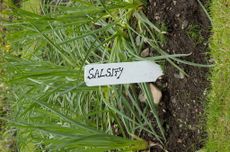What Is Scorzonera Root: How To Grow Black Salsify Plants


If you haunt the local farmers market, you'll no doubt end up finding something there that you have never eaten; possibly never even heard of. An example of this might be scorzonera root vegetable, also known as black salsify. What is scorzonera root and how do you grow black salsify?
What is Scorzonera Root?
Also commonly referred to as black salsify (Scorzonera hispanica), scorzonera root vegetables may also be called black vegetable oyster plant, serpent root, Spanish salsify, and viper's grass. It has a long, fleshy taproot much akin to that of salsify, but black on the exterior with white interior flesh. Although similar to salsify, scorzonera is not related taxonomically. Leaves of scorzonera root are spiny but finer in texture than salsify. Its leaves are also broader and more oblong, and the leaves can be used as salad greens. Scorzonera root vegetables are also more vigorous than their counterpart, salsify. In its second year, black salsify bears yellow flowers, looking much like dandelions, off its 2 to 3 foot (61-91 cm.) stems. Scorzonera is a perennial but is usually grown as an annual and is cultivated just like parsnips or carrots. You'll find black salsify growing in Spain where it is a native plant. Its name is derived from the Spanish word “escorze near,” which translates to “black bark.” The snake reference in its alternate common names of serpent root and viper's grass comes from the Spanish word for viper, “scurzo.” Popular in that region and throughout Europe, black salsify growing is enjoying a fashionable trending in the United States along with other more obscure veggies.
How to Grow Black Salsify
Salsify has a long growing season, about 120 days. It is propagated via seed in fertile, well-draining soil that is fine textured for the development of long, straight roots. This veggie prefers a soil pH of 6.0 or above. Prior to sowing, amend the soil with 2 to 4 inches (5-10 cm.) of organic matter or 4 to 6 cups (about 1 L.) of an all-purpose fertilizer per 100 square feet (9.29 sq. m.) of planting area. Remove any rock or other large impediments to reduce root malformation. Plant the seeds for black salsify growing at a depth of ½ inch (1 cm.) in rows 10 to 15 inches (25-38 cm.) apart. Thin black salsify to 2 inches 5 cm.) apart. Keep the soil uniformly moist. Side dress the plants with a nitrogen based fertilizer in midsummer. Black salsify roots can be stored at 32 degrees F. (0 C.) in a relative humidity of between 95 to 98 percent. The roots can tolerate a slight freeze and, in fact, can be stored in the garden until needed. In cold storage with high relative humidity, the roots will keep for two to four months.
Gardening tips, videos, info and more delivered right to your inbox!
Sign up for the Gardening Know How newsletter today and receive a free download of our most popular eBook "How to Grow Delicious Tomatoes."

Amy Grant has been gardening for 30 years and writing for 15. A professional chef and caterer, Amy's area of expertise is culinary gardening.
-
 Urban Beekeeping Guide: Top Tips For Raising Bees In The City
Urban Beekeeping Guide: Top Tips For Raising Bees In The CityUrban beekeeping can be a rewarding and appreciated pastime, but first be sure it’s legal in your city and learn the ropes of beekeeping.
By Mary Ellen Ellis
-
 2024 Plant Of The Year: Why Experts Say Philodendron Is The “It” Plant Of The Year
2024 Plant Of The Year: Why Experts Say Philodendron Is The “It” Plant Of The YearWe aren’t surprised that philodendron was designated the plant of the year. Versatile, easy-care and lovely, it’s the houseplant of the year 2024!
By Bonnie L. Grant
-
 Harvesting Salsify: Information On Harvesting And Storing Salsify
Harvesting Salsify: Information On Harvesting And Storing SalsifySalsify is grown primarily for its roots. These roots don't store well and, for most growers, harvesting salsify as it is needed solves these storage problems. Learn how and when to harvest salsify root here.
By Jackie Carroll
-
 Salsify Care - How To Grow Salsify Plant
Salsify Care - How To Grow Salsify PlantThe salsify plant is an old fashioned vegetable. Growing salsify as a garden plant is fun and unusual. Planting the vegetable is easy. Take a look at what is required to grow salsify in this article.
By Heather Rhoades